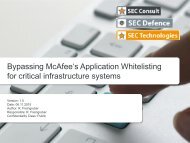1401-Baywatch
1401-Baywatch
1401-Baywatch
Create successful ePaper yourself
Turn your PDF publications into a flip-book with our unique Google optimized e-Paper software.
J. Poort et al. / Telecommunications Policy ] (]]]]) ]]]–]]] 7<br />
Table 4<br />
Downloading and streaming from illegal sources per blocking situation (two measurements, split sample).<br />
UPC, KPN, Tele2 and T-Mobile<br />
Ziggo and XS4ALL<br />
No blocking, t¼0 Blocking, t¼6 Blocking, t¼3 Blocking, t¼10<br />
Past 6 months 15.7% 18.4% 22.5% 25.2%<br />
oweek 6.0% 8.1% 7.8% 11.3%<br />
Week-month 3.7% 4.2% 6.8% 4.1%<br />
1–3 months 3.7% 3.4% 6.0% 5.4%<br />
3–6 months 2.3% 2.7% 1.9% 4.4%<br />
6–12 months 2.8% 3.3% 3.0% 3.5%<br />
4A year ago 9.5% 12.0% 13.2% 15.1%<br />
Never 72.1% 66.4% 61.3% 56.3%<br />
χ 2 43.6 942.8<br />
(p-value) o0.001 o0.001<br />
the intervention. For both sets of ISPs, the percentage of customers downloading very recently (preceding week or month)<br />
also increased. Thus, though a small share of downloaders reports a decrease in their downloading activities after the<br />
blocking, this effect is not reflected in the overall numbers. A likely explanation is that there are also new consumers who<br />
have started downloading from illegal sources, since the percentage of consumers that has never downloaded decreased<br />
over the measurements.<br />
4. BitTorrent monitoring<br />
4.1. Monitoring tools used and torrent samples<br />
The initial monitoring (April and May 2012) (Van der Ham et al., 2012) started as an ad hoc way to chart effects of the<br />
first blocking, by Ziggo and XS4ALL, in order to come up with measurements shortly after this intervention (see Fig. 1).<br />
A programmable interface of the popular Transmission client was used. By means of a script, a torrent magnet link was<br />
added programmatically, and then every minute the list of peers the client was interacting with was requested and stored.<br />
The default limit of peers to interact with was raised to 1024 (the maximum allowed) to record as many peers as possible.<br />
This methodology recorded activity on several magnet links at different times during a few days.<br />
The above method of recording peers yielded a list of IP addresses for each of the torrents. To convert this list to usable<br />
information, first the Team Cymru IP-to-ASN mapping service (http://www.team-cymru.org/Services/ip-to-asn.html) was<br />
used to record which ISP the IP address came from. This service has combined all the IP address registrations from the<br />
Internet Registries. Unfortunately, the country data from these registries is not always accurate. Many ISPs also have IP<br />
subnets registered as EU. To pin down the location further, the MaxMind Free GeoIP database was used (http://www.<br />
maxmind.com/en/country). In cases of conflicting results, the latter was preferred.<br />
In April 2012, 59 Dutch spoken or subtitled torrents were selected, which yielded a total of 12,942 Dutch peers. In May<br />
2012, 19 Dutch spoken or subtitled torrents were selected which yielded 2566 Dutch peers.<br />
The monitor described above is an active client, from which data are exported. The methodology provides a valid insight<br />
into the BitTorrent activity but could be improved on its effectiveness to record peer activity. Therefore, a new monitor was<br />
designed from scratch for the third measurement using Python and the libtorrent library. This library (http://www.rasterbar.<br />
com/products/libtorrent/) implements the BitTorrent protocol and is used in many popular BitTorrent clients. The new<br />
monitor uses the library to appear as an active client but is configured such that it does not download or upload any content.<br />
The monitor joins the torrent swarm and records activity, it requests a new set of peers from the tracker as often as allowed<br />
and records all these IP addresses. The monitor does not exhibit any suspicious behaviour as defined by Toro and Chothia<br />
(2009), because it only monitors a maximum of ten torrent swarms simultaneously and behaves like a regular client.<br />
The above monitor is a stand-alone process, which submits all its recorded peers to a database server, where they are<br />
stored and processed. Each peer record contains the IP address, the torrent it was recorded in, and the time it was recorded.<br />
During February 2013, the server and three monitors ran at different locations on the Internet and recorded activity in ten<br />
torrent swarms over a period of two weeks. After analysing the records with the Team Cymru IP-to-ASN mapping and<br />
MaxMind GeoIP database, 98,807 Dutch peers were obtained from ten Dutch spoken or subtitled torrents. As such, the new<br />
monitor proved to be much more effective than the former one.<br />
4.2. Results<br />
The Dutch peers were attributed to a total of 133 ISPs (108 of which recorded less than 50 peers over all measurements<br />
combined). While the court rulings primarily affect only six ISPs, these account for over 90% of Dutch residential broadband<br />
subscribers and of all Dutch peers recorded. Table 5 presents the percentage of Dutch peers for each ISP of interest for the<br />
three consecutive measurements. Although differences in the distributions of peers are statistically significant, changes are<br />
Please cite this article as: Poort, J., et al. <strong>Baywatch</strong>: Two approaches to measure the effects of blocking access to The<br />
Pirate Bay. Telecommunications Policy (2014), http://dx.doi.org/10.1016/j.telpol.2013.12.008i






